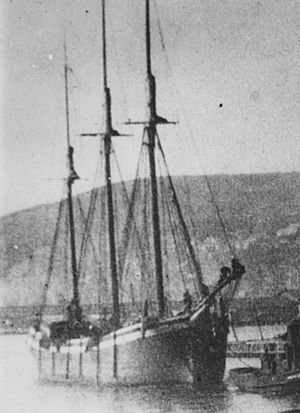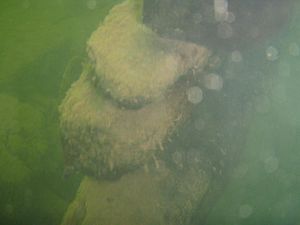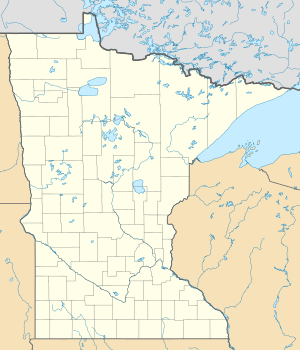Samuel P. Ely (shipwreck) facts for kids
Samuel P. Ely is the name of a shipwreck found near Two Harbors, Minnesota. This ship is so important that it's listed on the National Register of Historic Places, which means it's a special historical site. The Samuel P. Ely was a type of sailing ship called a schooner. It sailed on the Great Lakes, carrying heavy loads like iron ore and coal.
The ship was built in 1869. It was a typical 200-foot schooner from that time. However, it was made extra strong to handle the tough job of carrying iron ore.

The Samuel P. Ely
|
|
| History | |
|---|---|
| Operator |
|
| Builder | J.P. Clark Shipyard |
| Launched | 4 June 1869 |
| Identification | US Registry 23780 |
| Fate | Wrecked, 30 October 1896 |
| General characteristics | |
| Type | Topsail schooner |
| Tonnage |
|
| Length | 200 ft (61 m) |
| Beam | 31 ft (9.4 m) |
| Depth | 13 ft (4.0 m) |
| Capacity | 1,200 tons |
|
Samuel P. Ely Shipwreck
|
|

A closeup of some of the wreckage of Samuel P. Ely.
|
|
| Nearest city | Two Harbors, Minnesota |
| Built | 1869 |
| Architect | John Pearson Clark |
| NRHP reference No. | 92000694 |
| Added to NRHP | 18 June 1992 |
Contents
The Ship's Journey: A Life on the Lakes
The Samuel P. Ely started its career with the Winslow fleet. It often sailed from Escanaba, Michigan, to Cleveland, Ohio. Sometimes, it would also visit Marquette, Michigan.
In 1881, the Bradley Transportation Company bought the ship. As part of their fleet, it frequently served the ore docks. These docks were in places like Duluth, Minnesota, Ashland, Wisconsin, and Two Harbors, Minnesota. Later in its life, the Samuel P. Ely was often pulled by a steamboat. It acted like a barge behind steamers such as the Sarah E. Sheldon.
The Samuel P. Ely visited Two Harbors about 150 times. This was between the years 1884 and 1896.
The Day the Ship Sank: A Stormy Night
In October 1896, the Samuel P. Ely was traveling from Kelleys Island, Ohio, to Duluth. It was being pulled by a steamboat named Hesper. The Samuel P. Ely was carrying a load of limestone. The Hesper was also pulling another barge, the Negaunee.
They reached Duluth on October 27, 1896. The barges unloaded their limestone, and the Hesper unloaded its coal. On October 29, the Hesper headed to Two Harbors. It still had the Negaunee and Samuel P. Ely in tow. A big storm made their trip very difficult. There were strong headwinds and huge waves. The Hesper barely made it into port while pulling the Samuel P. Ely.
Around 8:00 in the evening, the Hesper had to let go of the towline. The crew of the Samuel P. Ely quickly dropped their anchors. But the anchors could not hold the ship. It drifted towards the breakwater, which is a wall built to protect a harbor. Around midnight, the ship got stuck against the rocks of the breakwater. It could not be moved. Finally, around 3:00 in the morning, the Samuel P. Ely sank. Luckily, the crew was able to climb onto the ship's masts and rigging. This saved them from drowning.
A Daring Rescue: Saving the Crew
The next morning, many people from Two Harbors watched from the shore. They wanted to help the crew, but rescuing them was tricky. A tugboat might get caught on the breakwater too.
Finally, someone came up with a clever plan. A tugboat named Ella G. Stone would get close to the wreck. Then, it would float a small sailboat out to the Samuel P. Ely. The sailboat would be tied to the tugboat with about 200 feet (61 m) of rope. This plan worked! It took three trips to bring all ten crew members safely to shore.
Protecting the Wreck: Deterioration and Preservation
The Samuel P. Ely suffered more damage after it sank. Recreational scuba divers found the ship in the mid-1950s. Local historians and divers noticed that many items were taken from the wreck. This happened between 1958 and 1961.
At first, small pieces of equipment were removed. In 1961, a large wooden anchor was taken. It was put on display in someone's yard in Superior, Wisconsin. The deck capstan (a machine used to pull ropes) was removed in 1974. It was taken to the Lake Superior Maritime Collections in Duluth. One of the deck winches was removed in 1978. It went to the SS Meteor Marine Museum in Superior. Another winch was taken to an unknown place. There were also stories of divers taking parts of the ship's red oak deck planks. They used them to make furniture and picture frames.
After the wreck was listed on the National Register of Historic Places in 1992, it became illegal to remove anything from it.
Over time, big waves and repairs to the breakwater caused the wreck to fall apart more. In 1994, a group of divers decided to help save the Samuel P. Ely. The ship's deck was starting to collapse into the hull. In March 1994, they did a series of dives under the ice. They lifted the deck through holes in the ice. Then, they put in 3/4 inch steel tie rods. These rods helped hold the sides of the hull together. Once the sides were secure, the deck was carefully put back onto its original supports. The group also put in simple tools to check how the hull moved over time. This group later became the Great Lakes Shipwreck Preservation Society. In 2001, they returned to do more strengthening work. They installed thicker steel rods with turnbuckles, which are devices used to tighten ropes or rods.



